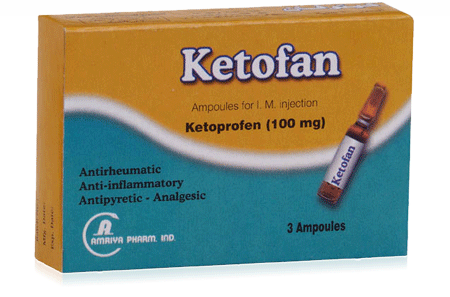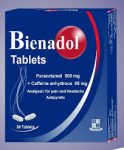
Ketofan Ampoules
Composition :
Each 2 ml ampoule contains:
Active Constituent: Ketoprofen 100 mg
Inactive Constituents: Arginine base (anhydrous), Benzyl alcohol, Citric acid (anhydrous), Water for injection.
Pharmacodynamics :
Ketoprofen an ary 1 carboxytic acid derivative. Is a non steroidal anti- inflammatory, belonging 10 the propionic group. It has anti-inflammatory, antlpyrencs properties and has central and peripheral analgesic activity. It Inhibits prostaglandin synthesis and platelet aggregation.
Pharmacokinetics :
Absorption:
– Successbe measurements of serum levels after administration of a therapeutic dose show that ketoproten is rapidly absorbed.
– Peak serum concentrations are reached from 20 to 30 minutes after intramuscular administration.
Distribution:
– Ketoprofen diffuses into the synovial fluid and in intra-articular, capsular synovial and tendon tissues.
– the mean plasma half-life is from 1.5 to 2 hours.
– 99% of kstoproten administered binds with plasma protein.
– Ketoprofen crosses the placental barrier and the blood brain barrier.
Metabolism:
– Ketoprofen is biotransformed according to 2 processes: a very minor pathway (hydroxytation) and a predominant pathway (glucuronic conjugation).
– Less than 1 % of the ketoprofen dose administered is found in the unchanged form in urine, whereas the glucuroconjugated metabolite represents around 55 to 85% of the dose administered.
Excretion:
Excretion, mainly urinary, is very rapid, since 50% of the dose administered is eliminated within 6 hours after dosing, whatever is the route of administration. In the elderly. ketoprofen absorption is not modified. The Increased elimination haft-life and the decreased total clearance may reflect a slower biotransformation. Patients with renal insuffldency. Plasma clearance ketoprofen is decreased and
the elimination haft-life increased correlated to the severity of renal failure. Patients with hepatic insufficiency. There are no significant changes in the plasma clearance and elimination hail-life. However, the unbound fraction is approximately doubled.
Therapeutic Indications :
The indications of Ketofan are based on its anti-Inflammatory, analgesic and antipyretic properties. Ketofan is indicated for symptomatic treatment 0f:
– Acute and chronic inflammatory rheumatic diseases, especially osteoarthritis, meumatoid arthritis, ankyloslng spondylitis, or other related syndromes.
– Soft tissue injuries, acute painful shoulder, tendinitis, bursitis.
– Low back pain.
-Musculoskeletal pain
– Traumatic injuries
– Pain regardless of the origin such as cancer pain, dental pain, headache
– Primary dysmenorrhea
Adverse Enects :
– Gastrointestlnal manifestations: gastralgia, abdominal pain, nausea, vomiting, constipation, and diarrhea. Gastritis, stomatitis, rarely colitis. The most serious adverse effects are: gastroduodenal ulceration, gastrointestinal nemormage and exceptionally Intestinal perforation.
– Headache, dizzjness, blurred vision, taste perversion, tinnitus, paresthesla, convulsions, somnolence, mood disorders, edema and weight gain.
– Hypersensitivity reactions 01 dermatological (urticaria, rash, pruritus, angioedema) and respiratory manifestations (possibility 01 asthmatic attacks and bronchospasm, especially, in patients allergic to aspirin and other NSAIOs). Anaphylactic reactions (including shock).
– In anemic patients, moderate fall in red cell count and a few cases of moderate leucopenia have been reported, thrombocytopenia and bone marrow aplasia.
– In patients with renal vascular disease, renal function should be monitored: few cases of renal failure have been reported in this situation, interstitial nephritis and nephritic syndrome.
– Skin reactions: Photosensitivity, alopecia, exceptionally bullous dermatosis.
– Local reactions: Pain at the site of Injection.
Warnings and Precautions :
Warnings:
Cardiovascylar Risk :
– NSAIDs may cause an increased risk of serious cardiovascular thrombotic events, myocardial infarction (MI), and stroke, which can be fatal. The risk may increase with duration of use. Patients with cardiovascular disease or risk factors for cardiovascular disease may be at greater risk.
– NSAlDs are contraindicated for the treatment of perrcperanve pain In the setting of coronary artery bypass graft (CABG) surgery.
Gastmiotestinal Risk :
– NSA!Ds cause an increased risk of serious gastrolntestlnal adverse events including inflammation, bleeding, ulceration, and perforation of the stomach or intestine, which can be fatal. These events can occur at any time during use and without warning symptoms. Elderly patients are at greater risk for serious
gastrointestinal (G!) events. Because of the seriousness of gastrointestinal manifestations, particularty in patients treated with anticoagulants, those patients should be especially monitored for the onset of gastrointestinal symptoms. Discontinue treatment in the event of gastrolntestinal hemorrhage. This product contains benzyl alcohol which Is potentially toxic when administered locally to neural tissue.
Precautions:
– History of gastroduodenal ulcer.
– At the start of treatment, careful monitoring of urine volume and renal function is required in patients wtth heart failure, liver cirrhosis, nephritic syndrome, chronic renal lnsufflciency, in patients on diuretics, and particularty in the elderly. Few cases of renal insufficiency have been reported.
– As with other NSAIDs, in the presence of an Infectious disease, it should be noted that the anti-Inflammatory, analgesic and antipyretic properties of ketoprofen might mask the usual signs of infection progression such as fever.
– In patients with abnormal liver function tests, or with a history of liver disease transaminases levels should be evaluated periodically, particularly during long-term therapy. Rare cases of jaundice and hepatitis have been described with ketoprofen.
– If visual disturbances such as blurred vision occur, treatment should be discontinued.
Effects on the ability to drive or operate machinery :
Patients should be warned of the risk of dizziness, somnolence or convulsions.
Interactions with other medications :
Concomitant administration of ketoprofen with following products requires strict clinical and laboratory monitoring.
Combinations not recommended :
– Other NSAIDs, including salicy/ales at high doses: increase In the risk of peptic ulceration and gastrolntestinal hemorrhage by exerting an effect of potentiation.
– Oral anticoagulants, heparin by parenteral roUlff and tic/opine: increase in the risk of hemcrrnaqe by inhibiting the function of the platelets and irritating the gastrolntestinal mucosa. If concomitant treatment cannot be avoided, careful clinical and laboratory monitoring (bleeding time) is required.
– Lithium: increase in plasma lithium levels, up to toxic levels by reducing the renal excretion of lithium. If combination is necessary,lithlum blood levels should be closely monitored in order to adapt the lithium dosage during concomitant treatment and after NSAIDs discontinuation.
– Methotrexate at doses more than 15 mg/Weelc increase in the risk of nematological toxicity of methotrexate, in particular, when administered at high doses (> 15 mg/week), by displacement from plasma proteins ancl/or decrease in renal clearance. Ketoprolen should be stopped at least 12 hours before methotrexate treatment and should not be administered for at least 12 hours after the end 01 methotrexate therapy.
Combinations requiring precaution for use:
– Diuretic: risk of acute renal failure particularty in dehydrated patients due to a decrease in glomerular filtration (reduced synthesis of renal prostaglandins). Such patlents shculd be rehydrated and renal function monitored at the start of treatment.
– Methotrexate at doses lower than 15 ma/Week: during the first weeks of combination therapy, blood count should be monitored weekly. In cases of alteration of renal functions or in elderly patients, monitoring should be more frequent.
– Pentoxifyltine: increased risk of bleeding. More frequent clinical and bleeding time monitoring is required.
Combination, to be taken into consideration :
– Antihypertensive (beta blockers, angiotensin converting enzyme inhibitors, diuretics): risk of reduction in antihypertensive effect (due to inhibition of vasodilator prostaglandins).
– Thrombolytics: increased risk 01 bleeding.
– Probenicid: marked reduction of plasma clearance of ketoproten may occur.
– Gemepfost reduced efficacy 01 Gemeprost may occur.
Overdosage :
– Cases of overdosage have been reported with doses up to 2.5 g of ketoprofen. In most instances, the symptoms observed have been benign and limited to lethargy, nausea, vomiting and epigastric pain.
– There are no specific antidotes to ketoprolen overoosaces. In cases of massive overdosages gastric lavage is recommended.
– Symptomatic and supportive treatment should be instituted to compensate for dehydration, to monitor urinary excretion and to correct acidosis, if present. If renal failure is present, hemodialysis may be useful to remove circulating drug.
Contraindications :
– Proven allergy to katoprofen and substances with a similar activity: asthma attacks have been observed in certain subjects, particularly to those with a hypersensitivity to aspirin.
-Active peptic ulceration.
– Severe hepatocellular or renal insufficiency.
– Concomitant anticoagulant treatment (risk of hematoma as for all injectable preparations by I.M. route).
Pregnancy, Nursing Mothers & Padiatric Use :
Do not administer injections preserved with benzyl alcohol to premature infants, neonates, children below 13 years, pregnant women or nursing mothers. Benzyl alcohol has been associated with serious adverse events and death, particularly in pedlatrtc patients (it may cause Gasping syndrome). Injections that are preservativelree should be used in these populations.
Dosage and Method of Administration :
Ketolan is administered by deep intramuscular injection at a daily dose of 100 to 200 mg, in two separate injections for a duration of 2-3 days. In cases 01 maintenance treatment, shift 10 the oral forms is needed.
Special populations :
Patients with impaired renal functions and elderly patients:
it is advisable to reduce the initial dosage and to maintain such patients on the minimal effective dose. Individual adjustments may be considered, only after good individual tolerance has been ascertained (see Pharmacokinetics section).
Patients with impaired hepatic functions:
These patients should be carefully monitored and daily doses of Ketofan kept at minimal effective doses (see Pharmacokinetics and Precautions section).
Children:
Safety and efficacy of ketoprofen have not been established
Package :
A carton box containing 3 ampoules, each of 2 ml + inner teaflet.
Storage :
Store at a temperature not exceeding 30 °C, protected from light.
Produced by :
AMRITA FOR PHAPMACUTICAL INDUSTRIES
ALEXANDRIA EGYPT


